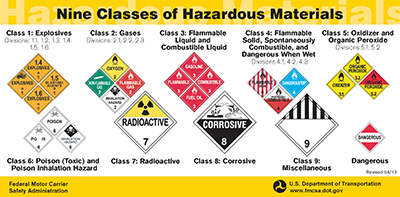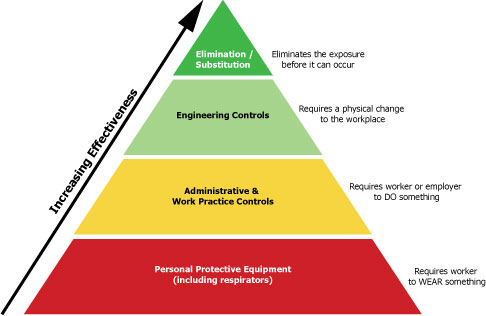Describe the Steps You Should Use in Handling Hazardous Materials
Store large bottles of liquid bases on trays in a cabinet marked Bases or Corrosives. It is the industry standard to follow an eight-step process if and when a HAZMAT situation should arise.

Level Hazardous Materials Would Cause At Level
Know the location of MSDS information sheets for all hazardous materials they may use.

. Label shelves and cupboards so that chemicals can be stored in the right place. Ensure clear segregation schemes are maintained. Evacuate any remaining persons and.
It wont provide adequate 4. Proper dispensing labeling and storage procedures. However even simple construction debris can become hazardous in a healthcare setting.
If the label is lifting off use a transparent tape to secure it. Keep the storage zone ventilated dry and cool. Never eat or drink while handling any materials and if your hands are contaminated dont use cosmetics or handle contact lenses.
Never pour them down sewers or drains. Hazardous materials are defined as those things that are not biological but still remain hazardous to human beings including patients and staff. These precautions may seem minor but theyll reduce the risk of a burn cut or other injury.
Keep your workers safe. Store solutions of inorganic hydroxides in polyethylene containers. Have spill control pillows or caustic neutralizers available for caustic spills.
Site Management Control Determine a safe approach to go in and take charge of the impacted site. For responding to a hazardous material spill Employees will receive department-specific spill management training about the hazardous products or chemicals used in that departmentunit Training for managing spills of hazardous drugs as defined by JHS Administrative Policy 400034 is providedavailable for. Follow procedures for handling biohazardous materials.
Do not use acids to neutralize. Here are 11 tips for handling hazardous materials. Demonstrate the safe handling techniques to staff and client.
Wear ANSI compliant chemical splash goggles with indirect ventilation in place when working with hazardous materials. 5 Reduce the amount of hazardous materials you keep in. Here are 5 quick tips to keep your operations up to date and keep your employees safe.
1 Use Proper Storage Materials In order to properly store hazardous materials make sure to use appropriate hazardous waste storage containers. Use placarding where required. When handling any hazardous material the user should always wear protective gloves and close-toed shoes.
Chemicals must be separated when being stored to ensure that incompatible chemicals do not mix if there is a spill. Be cautious and plan ahead. Dont mix or combine hazardous materials unless you know you can do so safely.
Dont become a target for one of these avoidable citations. After handling any material wash your hands thoroughly with soap and water. Quantify The next step of waste disposal is to determine how much waste is present.
Evaluate your waste to be able to handle the waste properly the company first needs to determine whether the waste is hazardous or not and whether handling of that particular waste is. Join us on March 29 for an in-depth webinar presented by Meaghan Boyd a seasoned environmental litigation partner at Alston Bird as she discusses best practices for hazardous. Make sure its safe to use.
Provide adequate ventilation. Use sealable containers that prevent the release of harmful chemical substances. ISO 14001 doesnt prescribe the steps in waste handling and every company can approach it according to its needs but there are some common steps in the process.
Examples of hazardous materials are chemicals. Lift in a careful deliberate manner and avoid any sudden lift movements. Employees who handle or work around hazardous materials should know and follow.
Make sure these storage areas are free from items that might cause trips falls or spills and free from materials that might encourage pests or rodents. Create a designated storage area for hazardous materials. Wear gloves and lab coats when handling especially hazardous chemicals such as toxins concentrated acids or concentrated bases.
You need to ensure that your workers are using the right safety containers properly labeled in the right area. Follow all established procedures and perform job duties as you 2. Many products can cause violent reactions or release poisonous fumes when combined.
Segregate bases from acids and other incompatible materials. Maintain the correct posture. Put all hazardous materials stored in the house garage or basement behind locked doors.
Some hazardous materials may require the user to don additional protective equipment such as a face mask protective goggles or nose plugs. Follow safe procedures when you handle hazardous material. Avoid bending over and keep lifts close to the body.
Clean work surfaces at least once a shift so that contamination risks are minimized. Always keep lids closed meaning leak-proof and vapor-tight on all hazmat containers. Never lift materials from a sitting position or twist to pick up a heavy object.
Keep chemicals in dry cool and ventilated areas and separate incompatible materials. The most common hazardous materials in healthcare facilities include mercury pharmaceuticals radiologicals sterilants and disinfectants cleaning chemicals laboratory chemicals and pesticides. Removing ceiling tiles cutting into drywall drilling and.
Identify it as a hazard zone and make it inaccessible to unauthorized individuals. Handle store and get rid of hazardous materials safely and according to approved procedures. Understanding the Hazardous Materials in Your Facility.
Close attention to what you are doing while working with or around 3. Use the original container to store the hazardous material. Some tips for storing hazardous materials.
Having safety procedures and awareness of how to deal with hazardous materials on any scale is essential to the safety of your staff the patrons of your facility and the environment. Ensure safe implementation of internal radiation therapy. Identify The first step of hazardous waste disposal is identifying the type of waste present and completing a waste profile to classify the waste and determine how to safely handle it through disposal.
Heres a list for safely lifting and moving materials.

Handling Hazmat On Amazon For Sellers Vendors

Shipping Or Receiving Dangerous Goods Environmental Health Safety Enterprise Risk Management Carnegie Mellon University

Rules For Safe Handling Of Hazardous Materials Chemical Safety Safety Guide Safety Posters

Chemical Hazards And Toxic Substances Controlling Exposure Occupational Safety And Health Administration
Comments
Post a Comment